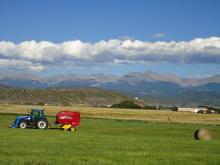Professor Devon G. Peña teaches popular classes on agroecology, the anthropology of food, and food justice movements. Peña brings a unique perspective to these subjects, as both an academic and a practicing farmer. A hands-in-the-dirt, drive-a-tractor, flood-irrigate, and pull-out-the-weeds-by-hand-or-hoe biodynamic farmer. Each year he goes to the family’s 200-acre Rocky Mountain farm where he produces hay and heirloom native corn, bean, squash, and pumpkin crops on a historic acequia farm located at 8,000 feet above sea level in southern Colorado’s San Luis Valley. The farm is also home to his family’s non-profit educational foundation, The Acequia Institute.
This summer (June 25-July 25), Professor Peña will teach the first annual “Acequia Agroecology and Permaculture Field School” at the farm in Colorado. Thefield school focuses on Native American and Chicana/o agroecology and permaculture as practiced in the acequia farms of the headwaters bioregion of the Rio Grande. The course is centered on an intensive experiential learning component on agroecological, restoration ecology, and permaculture methods and materials through practice based at working historic acequia farms in Colorado and New Mexico.
The Native American and Chicana/o communities of New Mexico and Colorado include the oldest continuously operated family farms in the United States. The bioregion of the Río Arriba or Upper Rio Grande is home to acclaimed acequia communities, which are celebrated across the world as sustainable, equitable, and resilient flood-irrigated farming systems adapted to the conditions of high altitude arid and semi-arid environments.
Students will participate in collaborative permaculture design projects. There will be four groups and each will be comprised of four or more students and their native acequia elder mentor(s). Each group will document the entire process of the design project and will prepare a multimedia report integrating video, audio, photography, maps, and a written narrative.
This summer the four projects will involve permaculture design work at the following acequia farms:
Almunyah Arellano Permaculture Demonstration Farm in Embudo, New Mexico.
The group will work on the design and construction of an edible landscape feature of conservation terraces and heirloom wine grape trellises with elder acequia mentors Estevan and Elena Arellano.
Rancho Dos Acequias in San Aacacio, Colorado.
Here, at the home of The Acequia Institute, the group will contribute to an on-going riparian zone restoration ecology project and assist in the planning and initial design work for a contour swale soil conservation pilot project for the field and row crop areas of the farm. Professor Peña will serve as the elder acequia mentor and will be joined by staff from the local USDA Natural Resources Conservation Services office.
Rancho de los Martínez in San Francisco, Colorado.
The group will work on the design and construction of a raised-bed polyculture milpa and a seed savers’ hutch with elder acequia mentors Junita and José Martínez.
Rancho Vialpando in San Francisco, Colorado.
The group will be divided with two students working on the design and construction of a dispensa, a storage structure built of locally harvested wood entirely without nails and two students working on the design and construction of an adobe horno (earthen-work oven). They will be instructed and supervised by elder acequia mentor Delmer Vialpando and his sons, Delmer, Jr. and Gary Vialpando.
1. Rancho Dos Acequias. Culebra Mountain Range in the background, the heart of the world's largest restored common lands (80,000 acres).
2. Culebra River at Rancho Dos Acequias
